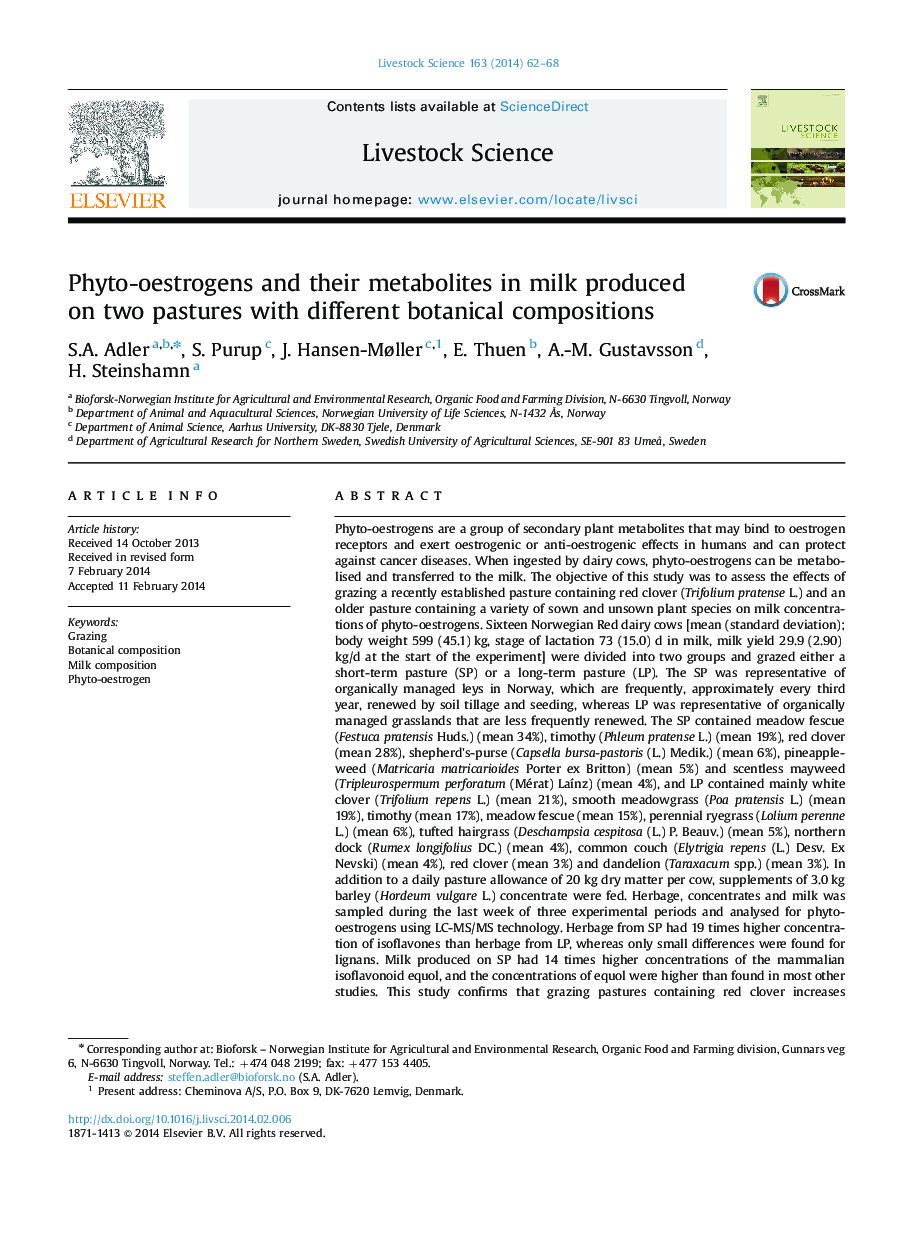| کد مقاله | کد نشریه | سال انتشار | مقاله انگلیسی | نسخه تمام متن |
|---|---|---|---|---|
| 2447213 | 1553969 | 2014 | 7 صفحه PDF | دانلود رایگان |
Phyto-oestrogens are a group of secondary plant metabolites that may bind to oestrogen receptors and exert oestrogenic or anti-oestrogenic effects in humans and can protect against cancer diseases. When ingested by dairy cows, phyto-oestrogens can be metabolised and transferred to the milk. The objective of this study was to assess the effects of grazing a recently established pasture containing red clover (Trifolium pratense L.) and an older pasture containing a variety of sown and unsown plant species on milk concentrations of phyto-oestrogens. Sixteen Norwegian Red dairy cows [mean (standard deviation); body weight 599 (45.1) kg, stage of lactation 73 (15.0) d in milk, milk yield 29.9 (2.90) kg/d at the start of the experiment] were divided into two groups and grazed either a short-term pasture (SP) or a long-term pasture (LP). The SP was representative of organically managed leys in Norway, which are frequently, approximately every third year, renewed by soil tillage and seeding, whereas LP was representative of organically managed grasslands that are less frequently renewed. The SP contained meadow fescue (Festuca pratensis Huds.) (mean 34%), timothy (Phleum pratense L.) (mean 19%), red clover (mean 28%), shepherd׳s-purse (Capsella bursa-pastoris (L.) Medik.) (mean 6%), pineappleweed (Matricaria matricarioides Porter ex Britton) (mean 5%) and scentless mayweed (Tripleurospermum perforatum (Mérat) Laínz) (mean 4%), and LP contained mainly white clover (Trifolium repens L.) (mean 21%), smooth meadowgrass (Poa pratensis L.) (mean 19%), timothy (mean 17%), meadow fescue (mean 15%), perennial ryegrass (Lolium perenne L.) (mean 6%), tufted hairgrass (Deschampsia cespitosa (L.) P. Beauv.) (mean 5%), northern dock (Rumex longifolius DC.) (mean 4%), common couch (Elytrigia repens (L.) Desv. Ex Nevski) (mean 4%), red clover (mean 3%) and dandelion (Taraxacum spp.) (mean 3%). In addition to a daily pasture allowance of 20 kg dry matter per cow, supplements of 3.0 kg barley (Hordeum vulgare L.) concentrate were fed. Herbage, concentrates and milk was sampled during the last week of three experimental periods and analysed for phyto-oestrogens using LC-MS/MS technology. Herbage from SP had 19 times higher concentration of isoflavones than herbage from LP, whereas only small differences were found for lignans. Milk produced on SP had 14 times higher concentrations of the mammalian isoflavonoid equol, and the concentrations of equol were higher than found in most other studies. This study confirms that grazing pastures containing red clover increases concentrations of isoflavones and especially equol in bovine milk compared to grazing pastures with other botanical composition. The higher milk concentrations of the lignan metabolite enterodiol in milk from SP compared to LP could not be related to differences in intake of the analysed lignans and may therefore be related to unidentified lignans.
Journal: Livestock Science - Volume 163, May 2014, Pages 62–68
